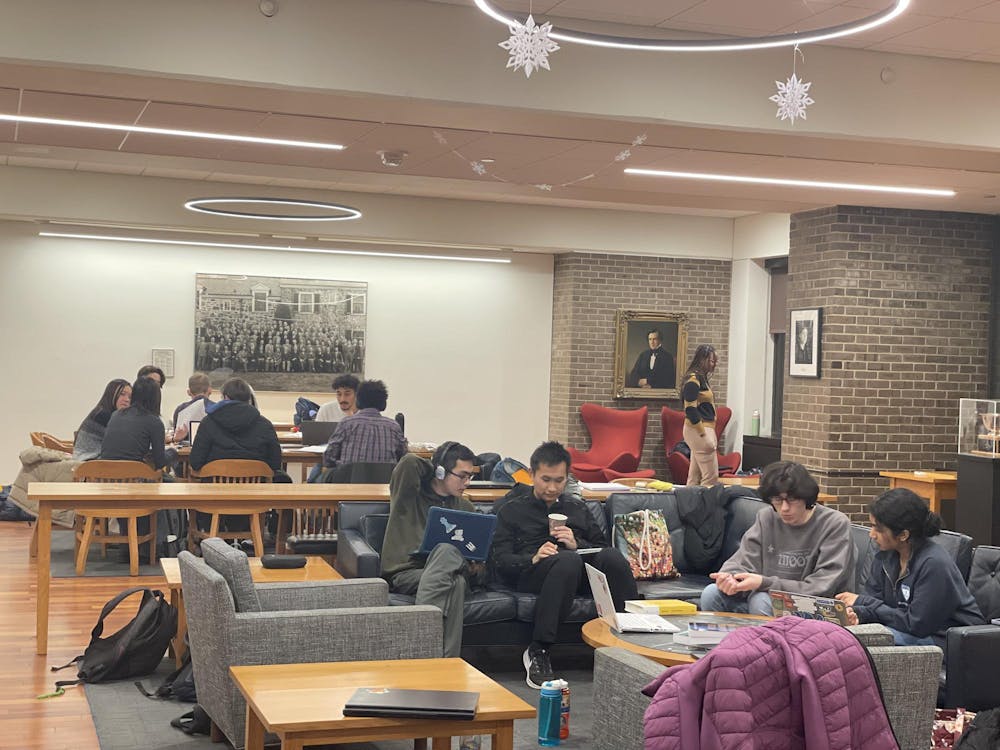When I first started working at the Engineering Library Circulation Desk my first year, a friend I met during Outdoor Action invited me after my shift to visit him on the third floor of Fine Hall, home to the building’s common room. Soon enough, it became a place I returned to time and time again — to talk about crushes, have cookies and fruit, use the coffee machine, do my Italian homework, and even attempt to understand some of the math the students were doing.
As a SPIA major, I technically wasn’t “supposed” to be there, yet the Fine Hall common room became a space where my social anxiety seemed to melt away. The struggle of taking my first math class since freshman year of high school was only bearable because of the support of the math students. There was always someone willing to help explain a concept or just sit with me as I worked through problems so that I wouldn’t feel alone. The room itself had an unspoken understanding that no one was left to struggle by themselves with a problem, and that support — whether academic or sometimes even personal — was always a piece of chalk or shoulder tap away.
The Fine Hall Common Room isn’t just a study room lined with dozens of chalkboards — it’s where those who often feel isolated by their passion for math, or the societal pressures of the Princeton bubble, find a sense of belonging. Math majors or not, those who have experienced the Fine Hall Common Room are always drawn back to its sense of community and friendship.
Shreya Sinha ’26 is one of the students you might meet if you stop by the common room. She spends three to four hours there daily, drawn by the perhaps surprisingly collaborative nature of math — a quality she believes isn’t widely recognized.
“Math is often thought of as solitary, but in reality, it’s easiest to grasp when you’re bouncing ideas off of people who have taken the same classes or have different perspectives,” Sinha explains. The space, filled with a mix of graduate students, professors, and undergraduates, creates the perfect environment for spontaneous discussions.
“One of my professors even stopped by last semester when he saw me working on an interesting problem and just sat down to ask me about it,” Sinha recalls. The communal atmosphere extends beyond academics — every afternoon, Teatime brings students together over a wide range of biscuits and fruit, offering a chance to catch up with friends, casually approach their professors, or simply take a break from the MAT 218 problem set that has been consuming their days.
For Ezekiel Douglasrosenthal ’27, the common room isn’t just the most convenient place to tackle his multiple p-sets a week — it’s also the perfect spot to forget about the intricacies of the outside world.
“One night during exam season, we decided to take a break and make origami snowflakes. We stuck them to the ceiling as a joke, but when the staff said they were going to keep them up, it felt like we had left a small piece of ourselves in the space,” Douglasrosenthal recalls. To this day, visitors can still spot their handiwork hanging from the ceiling lights.
Sophia Huellstrunk ’25 remembers a time when the common room wasn’t as welcoming — particularly during COVID-19. She believes the community has come a long way since then, and the two to three hours she now spends there daily have become the highlight of her Princeton experience.
“It used to feel very quiet and exclusive, but now, there’s always a lively group around the coffee table, and you can jump into any conversation,” Huellstrunk shares. She loves the chalk-covered coffee table, where students constantly scribble down equations and diagrams, and she adores the red velvet cookies that sometimes appear at Teatime.
Andrew Pitolaj ’28, a physics major, didn’t initially expect to spend much time in the math department but found himself returning there.
“It’s just such a chill place,” Pitolaj says. “I thought I would be intimidated by the math prodigies, but instead, it’s one of the most welcoming places on campus.” Pitolaj often stays late — sometimes until 3 or 4 a.m. — because it’s one of the only places where he can actually concentrate. The coffee machine, despite the occasional inconvenience of it sometimes being broken, only adds to the homey feel of the space. “When you see someone working on higher-level math, it doesn’t make you feel out of place — it inspires you,” Pitolaj adds.

I've come to realize the Fine Hall Common Room is more than just a gathering space — it’s a home where a sense of community forms naturally over years of friendship and love for math. Whether it’s a professor casually explaining a theorem over coffee or a game of Four Square in the pavilion after being impromptu recruited in the common room, there’s a blend of academic rigor and social connection. Students huddle around chalkboards brainstorming solutions, while others lounge on couches flipping through textbooks. Chess matches unfold in one corner, and curious passersby pause to observe the discussions scribbled across the coffee table. It’s not uncommon for alumni to return, reminiscing about their own time in the common room and reconnecting with current students, sharing stories and advice that bridge generations of mathematicians.
For these students, math isn’t just a subject — it’s a way of life. As Elie Belkin ’26 puts it, the Fine Hall Common Room offers students an outlet to express their interests, goals, and hobbies.
“Most of us came from a solitary path in math,” Belkin says, “but this place turns something isolating into something communal and fun.” It transforms what can often be a lonely academic pursuit into a shared experience — one that fosters not just problem-solving but deep, lifelong friendships.
As I was preparing to leave, the students of the common room went back to finishing a p-set. Others returned with their late meal box of sushi while continuing casual debate about a complex proof. A student struggling with the weight of dozens of math books packed them into a wagon — his backpack simply couldn’t hold them all. The atmosphere was the same as when I was first invited as a first-year, and I hope that never changes.
Ruxandra Iosif is a junior in the Class of 2026 in SPIA, pursuing minors in Entrepreneurship and Journalism. She is a contributing writer for The Prospect for the ‘Prince.’ Originally from Romania, she can be reached at ri3238[at]princeton.edu or on Instagram @ruxandra_cristina.
Please send any corrections to corrections[at]dailyprincetonian.com.








